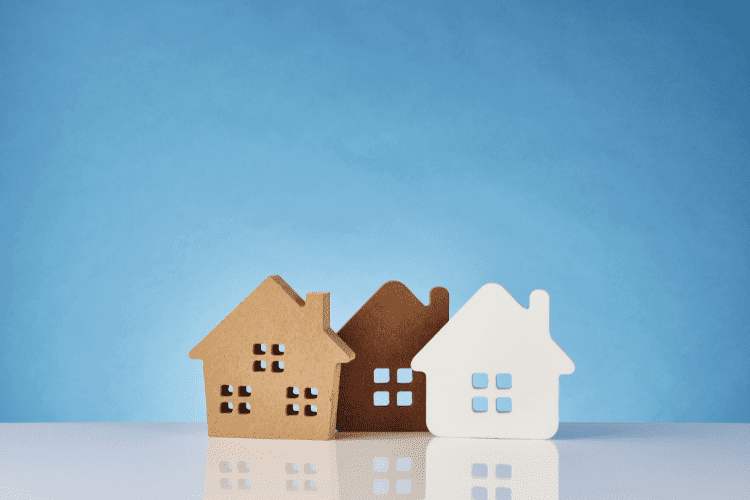Is the American Dream of Homeownership Fading?

Decades ago, US citizens were widely able to realize the classic American dream of homeownership. Hopeful immigrants streamed our shores to take advantage of the promise of safety and security homeownership offers. In 1945, as World War II was ending, the median cost of an American home was around $3,000. Yes, you read that correctly, and no, we didn’t forget any zeros!
Mortgage interest rates were also quite favorable. At 1.8%, they easily beat the current mortgage rates that the financial and real estate industries are touting as “historically low.”
Fast Forward to 2022
An average American home now costs in the neighborhood of $269,000, but prices are many times higher in densely populated cities. Due to the convergence of several market forces, home prices rose sharply—by as much as 24%—when the global pandemic took hold of our economy. If you’re looking for a house right now, you may find yourself short on choices. You might also find yourself in a bidding war, as home sellers are holding firm on their asking prices, and many homes are selling for much more than their listed price.
That’s not to say that the housing story is entirely gloomy. The homeownership rate among US residents has steadily increased across the board since the end of the war. Minority homeowners were on track to significantly, though certainly not entirely, close the gap between themselves and whites in achieving the goal of homeownership. Indeed the gap narrowed steadily over several decades, but in recent years, it’s been widening again.
Suffice to say, aspiring homeowners of every demographic are facing significant challenges. While home prices have been rising, wages among the middle class have largely stagnated. Inflation is taking a big chunk out of paychecks, so it takes longer to save enough money for the preferred 20% down payment. A shortage of skilled laborers has made home maintenance expenses more costly as well. Energy costs also make it more expensive to keep the lights and the furnace humming. So what can you do to increase the chance you’ll be able to afford to own a home? There are a few proven strategies that can help.
Build Your Credit
The interest rates that financial institutions advertise can be misleading. Unless you are extremely credit-worthy, with a credit score of, say, over 800, you’re going to pay more than the rate touted by mortgage lenders on their websites. Before you apply for a mortgage, it’s essential to do everything you can to boost your credit score. The first step is to download your free credit reports from all three major credit monitoring bureaus, Equifax, TransUnion, and Experian.
Many people don’t realize that having no credit history is detrimental to your score. Using credit responsibly is the key to having a high credit score. If you’ve never applied for credit before, it’s best to start small by opening a retail credit account or a gas station credit card. Make small purchases every month and pay them off habitually by their due dates.
Perhaps you’ve made a few credit mistakes in your lifetime. You’re certainly not alone. Credit repair is a time-consuming process. You can’t boost your score by much overnight, despite what you hear on TV. But by bringing all of your accounts up to date, closing accounts you’re no longer using, and not applying for new accounts before applying for a mortgage, you can make some headway. In addition, you should check your credit report for mistakes. They happen more frequently than you think! Removing false-negative remarks on your credit report can be tedious—you have to contact all three credit bureaus in writing for each mistake you find. It may be worth your while to hire a professional credit repair company to assist you.
Investigate Government-Guaranteed Mortgages
The federal government has long invested in the American dream of homeownership. The first government-guaranteed mortgages were the product of the Federal Home Loan Bank Act, which was passed in 1932 in response to the housing crisis created by the Great Depression. The first Veteran’s Administration (VA) mortgages were offered in 1944 as part of the GI Bill, a comprehensive slate of benefits that awaited returning World War II vets.
Today, the US government offers US Department of Agriculture (USDA) and Federal Housing Administration (FHA) mortgages, as well. While private lending institutions administer them, all of these mortgages have one thing in common: if a borrower defaults on one, the federal government is obligated to repay the remaining amount owed on the loan. That means lenders consider these loans less risky, and since interest rates are driven by risk, government-guaranteed loans almost invariably offer lower rates.
VA loans are available to veterans, active service members, and surviving spouses of veterans until they remarry. That’s a fair chunk, but not a majority of Americans. But USDA loans come with a different set of eligibility requirements. Many homebuyers would be surprised to learn that USDA loans, which were designed to encourage the development of our nation’s rural areas, aren’t just for tiny town dwellers.
By some estimates, 97% of locations in the US are USDA-loan-eligible. Typically, any property located where the population is under 20,000 may be purchased as a primary residence through a USDA mortgage. Lots of suburbs fit that description. You do need to meet certain income and credit qualifications to be eligible for a USDA loan, however. They’re offered exclusively to low- to middle-income borrowers. You’ll also need a credit score of at least 640 to be approved, but that’s a lower score than required by many traditional loan products.
Explore Your Down Payment Options
Times are tough. Many of us work two jobs to keep ourselves and our families afloat. Setting aside the traditional 20% of your home’s selling price that many lenders require as a down payment can be a daunting task for some prospective homeowners.
If you’re having trouble saving enough for a large down payment, that doesn’t mean you can’t buy a home. If you’re eligible for a VA or USDA loan, you may not be required to put any money down on your house. Government-guaranteed FHA loans are designed for homebuyers of varying income levels. There are no geographical restrictions on FHA loans, either. To be eligible for an FHA loan, you may be able to put as little as 3.5% of your home’s purchase price down.
Bear in mind, though, that the more of your own money you wind up putting down on your home purchase, the lower the rate you will likely be offered. Lenders do like to see homebuyers put some skin in the game.
Choosing the Best Mortgage Lender
There are tens of thousands of lenders vying for your mortgage business. Before you decide to take out a mortgage, it’s important to talk to—or at least communicate digitally—with a series of them. You may want to start by checking your financials and creating a strict budget for home buying. After that, try speaking to a loan officer at the bank where you keep your checking and savings accounts. Banks value existing customers and don’t want you taking any of your business elsewhere.
Do you belong to a credit union? You may want to open a small account with one before applying for a mortgage. Credit unions are not-for-profit institutions whose mission is to serve their members. Often, credit unions offer mortgage rates that are lower than the rates offered by traditional banks. They may have more lenient credit qualifications, too.
In recent years, the banking industry has been transformed by the emergence of hybrid businesses known as financial technology companies. Fintech companies offer many of the lending services traditional banks do, including mortgages. Many offer both private and government-backed home loans. Fintech companies have streamlined the process of shopping for, applying for, and closing on mortgages. Many are not direct lenders themselves but rather partner with multiple financial institutions to offer borrowers a wide range of mortgage options. Because they operate very efficiently and entirely in the digital world and have developed technological solutions that reduce the cost of doing business, fintech companies can be highly competitive, as well.
The point is that if you want to find a mortgage product that’s not only economical but also suits your unique needs as a borrower, it’s essential to take the time to comparison shop. If you find the whole subject of mortgage finance confusing (as many first-time homebuyers do) or can’t dedicate the time to researching your options, you can also engage a mortgage broker to do the heavy lifting for you. Mortgage brokers can also be helpful if you’ve been turned down for a mortgage in the past and want to increase the odds of getting approved. Like fintech companies, mortgage brokers work with a lot of lenders and can sometimes find the mortgage solution that’s been evading you.
If you’re looking for specific lender recommendations, turn to friends and family members. Ask them who earned their mortgage business and why. A licensed realtor can also be a trustworthy ally in your search for the mortgage that puts you where you want to be: safe, secure, and comfortable at home.
Read More:










